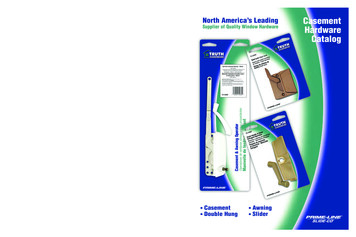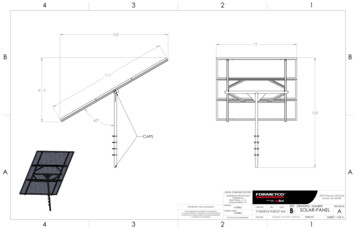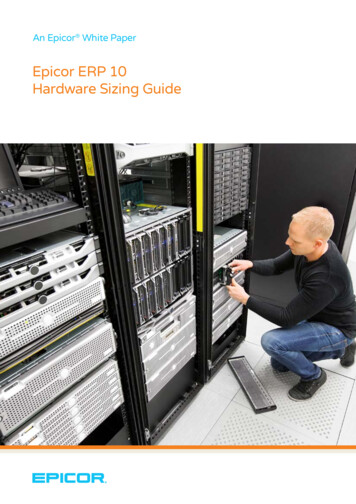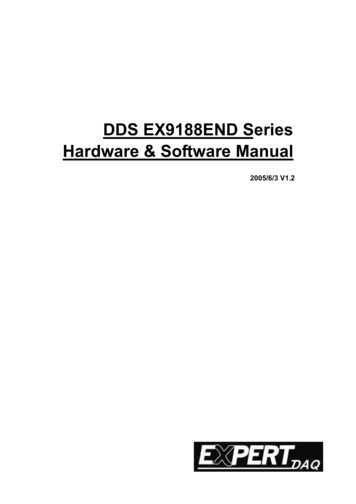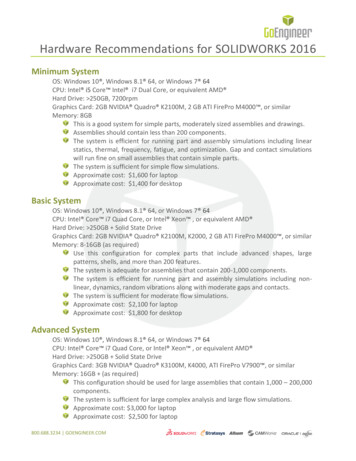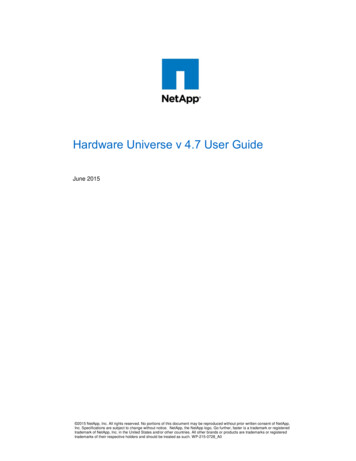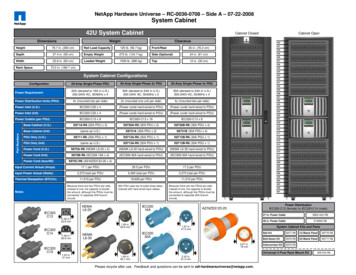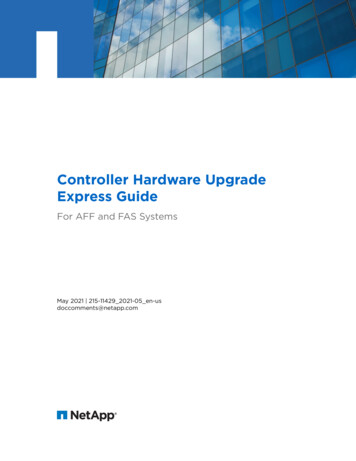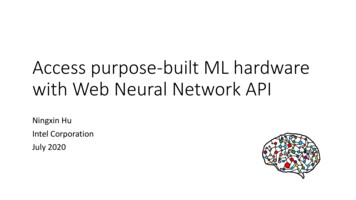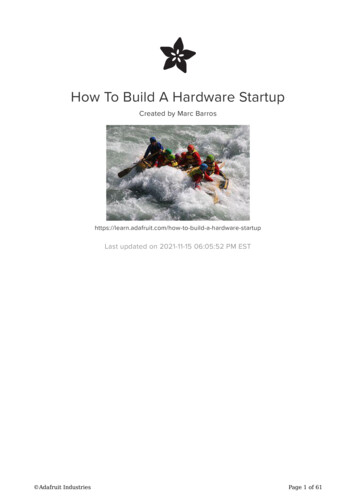
Transcription
How To Build A Hardware StartupCreated by Marc rdware-startupLast updated on 2021-11-15 06:05:52 PM EST Adafruit IndustriesPage 1 of 61
Table of ContentsKnow Your Why5Have A Purpose7Picking Your Co-Founders9Finding The Right Market11 Identifying A Positive Market Narrative Finding Passionate Customers1212Minimal Viable Product14 1515161718Talk To PeopleMap Out The Entire Customer JourneyOnly Ship the Core NeedBuild On Your FoundationConclusionPricing Your Product18 1919212223Profits MatterKnow Your CostsTop Down PricingBottom Up PricingConclusionCreating Your Brand Start With the HistoryPick an ArchetypeDefine Your AttributesCreate StoriesBring It to Life242425262626Picking A Brand Name28Picking The Right Supplier30 Finding SuppliersStart With QualitySupplier With ExperienceCheck Their Engineering AbilitiesNegotiating The AgreementDeciding to Crowdfund Why You Should Why You Shouldn't Best PracticesLife After Crowdfunding Keep Talking To Your BackersBe Ready to To Sell DirectConstantly Be MarketingCreate A Plan Adafruit Industries3131323233343435363738383839Page 2 of 61
Building Retail Distribution40The Cost of Retail41 414243434444Retailers Are Not MarketingRetail Ready ProductIn Store ExpectationsBig Box is Really BigInternational Is a MultiplierFinancial ModelBuilding Brand Awareness 46Understand the FunnelStart With Existing CustomersOnline SearchPRTrial and ErrorConclusion474748484949Poor Quality Will Kill You50 Understand The Financial ImpactNail the Basic ExperienceWork With Production Engineers EarlyConstantly Be Checking QualityHave Amazing Customer ServiceConclusionHardware Startup Metrics 51515252535454Cash Is KingReaching Market FitGrowing Your CompanyConclusionCash Is KingReaching Market FitGrowing Your CompanyConclusion Adafruit IndustriesPage 3 of 61
Adafruit IndustriesPage 4 of 61
Know Your WhyIt's a simple question: Why are you starting a company?It's hard to answer. Either because you don't know or you are embarrassed about howsimple the reason is.The good news is you can get away without have a clear why for a very long time.Most people will never ask you, instead they will focus on what you have built.The bad news is down the road then the deck is stacked against you, when you areexhausted from the journey, and when you are wavering between a crappy and areally crappy decision, not having a clear why make you a leader without a compass.To figure out your why, here is a simple exercise you can take yourself through: List what you are passionate about. List all the reasons you want to start a company. List all the emotions and desires you feel. (Frustration, hope, happiness, wantingfreedom, etc) Adafruit IndustriesPage 5 of 61
List what you want to change, improve, or make better in the world. These couldbe literal to the activity (i.e., make something easier), the feeling your customerswill have (i.e., make people happy), or something you want to change (i.e., makethe world better).Once you create these lists you can step back and find the common thread. Whilebeing honest with yourself can be hard, it's necessary if you want to be a greatentrepreneur. If you can't understand why, you will start and run the wrong company.As you discover your why, I'd like to leave you with this thought: Don't do it for themoney. (https://adafru.it/cOc)Because if you do, it changes everything. You start with a spreadsheet instead of areal problem in the world. The people around you turn into costs. Your brand isreferred to as an asset to be leveraged. Your customers become annoying peoplewho won't leave you alone. Your handshake gets replaced with a legal contract thatprotects you in all circumstances. You start taking short cuts expecting the acquiringcompany to fix it. You stop worrying about making your culture great because it won'tmatter once everyone makes money.You will destroy the very masterpiece your are trying to build.Instead, choose to take this journey because no matter what happens at the end ofthe day you are happier after your company than before it. If not, when you don't havea pile of money, your company fails, or you're on the outside looking in, you won't behappy. Adafruit IndustriesPage 6 of 61
Have A PurposeIn the start-up world, purpose isn’t talked about. Unless a founder is determinedenough to drive home their beliefs, the conversation always starts with, “So what doyou do?”Especially in the beginning, having a purpose can be terribly lonely. Finding otherswho share your same beliefs takes a lot of time. If you have a consistent commitmentto start with “why” instead of “what,” you will spend a lot of time meeting people whojust don’t understand.Simon Senick (https://adafru.it/cOd) says it best, “people don’t buy what you do, theybuy why you do it.”The Marines are an incredible organization. Whether you believe in the military or not,there is no denying that every Marines have an unwavering sense of purpose.Whenever I see a Marine in uniform, I can’t help but notice because they have such apresence to them, a strength that leaves no doubt about the reason they wear theircolors. Adopting the mark, Semper Fi (Always Loyal), members of the marines areclear about why they exist.Most startups don’t have this same loyalty or this same collective unity. The startupculture has become one of minimal viable convincability. A culture focused onquantity over quality, we are in a rush to convince a lot of people that *what* we arebuilding is meaningful. Because if not, the best talent won’t join, investors will pass,and we will spend a lot of time coming up with new ideas until something sticks.Your company will stand for one thing, which means you must be clear about what it Adafruit IndustriesPage 7 of 61
is.To provide inspiration “We make things that work for people.” Nest (https://adafru.it/cOe) “Tools for living the city.” Chrome Industries (https://adafru.it/cOf) “Enhance each life we touch.” Apple (https://adafru.it/cOg)Just because the product you make doesn’t save lives, doesn’t mean you can’t have adeeper purpose. Personally, I love photography and as a former camera maker Idefinitely believe that the world is a better place with beautiful pictures. Even if I wasgoing to add more plastic to the world by making another camera, I would want to tieit's existence to impacting the world through beautiful pictures.“Making the Web a Better Place and loving every second of it” Moz (https://adafru.it/cOh)A simple purpose, Moz is focused on making the web a better place for its customers.Empowering people to optimize their business, Moz is consistently telling the worldwhat they believe in. Whether it’s their purpose, their TAGFEE values, or theircomplete transparency, Moz is clear about what they believe in.At the end of the day, nothing matters unless you measure it. Sticking a purpose onthe wall that is not tied to what you track, is pointless. If all you measure is revenue,customer engagement, and profits, then you should just change your purpose to, “Weare leveraging our customers so we can make as much money as possible.”Instead, spend time on creating a single purpose, measuring it, and telling the worldabout it. When you are winning people will follow you, but when you hit a massivebump in the road having a team with shared beliefs is the only way to survive it.Image Credit: No Author (https://adafru.it/cOi) via Creative Commons Adafruit IndustriesPage 8 of 61
Picking Your Co-FoundersPicking a co-founder is as personal as picking a spouse and as financially binding aspicking an investor. Co-founders are the pillar of your company and a relationship youneed to spend real time thinking about.When looking for the right co-founder, the best place to start is by spending time withpeople. And not just a coffee meeting. Spend time with them for breakfast, lunch,dinner, and the bar. Figure out if you like the person in the morning as much as theevenings. Spend time talking about ideas, business philosophy, family, food, interests,life, etc. Just like when you date you want to find out if you have similar interests.In your discussions, you want to find out three things.1. What are they passionate about?2. What kind of company do they want to build?3. What is their cost structure and appetite for financial risk?You need to be able to talk about your answers. It's one thing to write them down butyou have to be able to talk about them openly. Talking about your feelings can behard, but you have to. You have to ask questions that make both of you vulnerable. Ifyou can't do this, you will never be able to have the type of communication you needdown the road. A co-founder is like a spouse, you have to be able to talk abouteverything.If you don't believe in the same things, end the dating. You CAN NOT compromise onwhat you believe in or you'll end up the cliche spouse in the relationship admittingyou gave up on your dreams when you got married. Adafruit IndustriesPage 9 of 61
Along with similar beliefs you want to know they aren't going to give up. An easysolution is picking a fellow co-founder who has also started a company. Joining oneearly is nice, but finding someone who has been through hell and back as a founderis an invaluable experience.If they haven't started a company you want to go back to their roots and understandwhat tragedies they have faced, what set-backs have they had to overcome, or whatchallenges have they beat. This can include a variety of life experiences from a roughchildhood to losing someone to excelling at sports. You are looking for experiencesthey can talk about that took incredible personal commitment to overcome.When you are in the dating phase with your potential new co-founder, BEOBSERVANT. Looking at small things can tell you a lot, such as how do they talkabout other people, are they positive or negative, do they follow through, and/or arethey on time? Small clues tell you a lot about the person, signs you want to pick up asearly as possible.Once you have established your new co-founder relationship I STRONGLYrecommend that every founder (including you) earns their ownership over four years.For example, if someone leaves after two years then they get half of their equity. Thisis very, very important because you can't predict the future and you can't afford amassive amount of equity being held by a former co-founder who is no longerinvolved with the business. Relationships don't always work out and you have tostructure the company with a fair way to reward people for the time they put in, whileproviding the company with an easy out if the person leaves fro whatever reason.Your company won't have cash to buy them out, so equity for time is the only way togo. If a co-founder is not willing to do this, walk away.Getting to this point in the relationship is the most important part. If you have thesame beliefs, a strong chemistry, totally open communication, and you know theperson won't give up, you can figure out the rest. Determining roles, ownershipstructure, which idea to pursue, etc can be worked out. In fact, working these outtogether will better confirm your choice to take the co-founder plunge. Adafruit IndustriesPage 10 of 61
Finding The Right MarketInvestors love to talk about market size. It’s the part in your presentation where theirears perk up and they start doing the math in their head about what it takes to be abillion dollar company. Conversely entrepreneurs waste countless hours trying to findmarket numbers that justify why they have a billion dollar idea.In reality it doesn’t work like that.A lot of the best hardware brands start by solving a single, niche problem and overtime become billion dollar opportunities. Skullcandy (https://adafru.it/cOj) startedbecause the founder wanted to listen to music while he snowboarded and he gottired of taking his gloves off to answer his phone. Jawbone (https://adafru.it/cOk)began with technology to help soldiers better communicate in noisy environments. GoPro (https://adafru.it/cOl) was a cheap camera you wore on your wrist to capturephotos while you surfed.One of the things that makes hardware startups so expensive to build, is the cost toacquire a new customer. The use of online and offline marketing tactics means youspend a lot of money trying a variety of ideas that are difficult to measure, hopingthey result in positive sales.In the end, you come to realize that the more niche and passionate your initial marketis, the easier it is to grow your customer base. If you can profitably gain morecustomers, you can build a really successful hardware company. If you can't, younever get past your Kickstarter backers. Adafruit IndustriesPage 11 of 61
In finding a the right niche, you first want to identify the right market trends andsecond find a set of customers who are passionate about the problem you aresolving.Identifying A Positive Market NarrativeI’m a big believer that finding the right market is about understanding the narrative (https://adafru.it/cOm) behind it. The numbers are helpful in estimating total size, but thetrends within and around the market are more important.Take the elderly population in the US. By running a few google searches you can seethat the elderly population is expected to nearly double in size over the next 15 years.That’s a staggering result, which means this increased market segment will be lookingfor products that make their life easier.Lively (https://adafru.it/cOn) is a startup that is hoping to ride this positive marketmomentum to success. Their use of sensors and a mobile app gives the entire familyconfidence that the matrons of the family are safely going about their day.Smart locks on the other hand, don’t have the same market momentum. Yes peopleare continuing to buy products that are connected to their phones, but there isn’t astrong narrative that says people are buying more locks. Because the housing marketisn’t growing, these new companies will be hoping that the growth in home rentalsites, like AirBnB, will be enough to drive the need for keyless locks. Otherwise thesenew startups will be competing on features, trying to convince all of us why a smartlock is better than a dumb lock.Keep in mind, the size of your market doesn’t have to be increasing to have a positivenarrative. Digital cameras are being replaced by mobile phones, but it doesn’t meanpeople are taking less pictures today. In fact the opposite is happening, which meansthere is increasing momentum for photography, even though the tools we use arechanging.Finding Passionate CustomersWithin a positive market narrative you want to identify customers who are excitedabout the problem you are solving. Not only will it drive valuable word of mouth, but itwill also result in a customer base that is willing to spend money to buy your product.To identify passionate customers I use a simple matrix. On one axis is how frequentlyconsumers use your product, the higher the frequency the better. The second axis is Adafruit IndustriesPage 12 of 61
the reason behind their purchase. Products that bring joy (i.e. make your life better)are a marketing sell, while products that solve pain (i.e. a chronic problem) are aninformation sell.At Contour (https://adafru.it/cOo) we were successful because outdoor enthusiastsfrequently participated in their sport and received an incredible amount of personalsatisfaction from recording their adventures. The competitive nature of sportcombined with the desire to remember were powerful drivers in people needing anaction camera.The maker movement is another great example. It’s a niche segment of Do-It-Yourself(DIY) builders that spend their weekends hacking together new product ideas. Makerbot (https://adafru.it/cOp) realized this and focused intently on building 3D printersthat were convenient, high quality, and affordable for them to use.SoundFocus (https://adafru.it/cOq) on the other hand is a new startup focused onhearing loss. Starting with a mobile app that makes music on your phone soundbetter, they will soon introduce hardware that challenges existing hearing aides. Thefounder’s experience with hearing loss is a problem he deeply understands, whichgives them an important advantage in solving a problem that is high in frequency andpain. Adafruit IndustriesPage 13 of 61
Going back to smart locks it’s hard to see where they fit on this matrix. Losing yourkeys sucks, but does the problem happen enough to warrant replacing your locks?People who rent their homes on a regular basis, frequently need to provide access,but are there enough home renters to justify a market with three startup competitors?Time will tell.ConclusionIdentifying the right market narrative and finding a passionate consumer with in it, iscritical to finding hardware startup success.Image Credit: The Rocketeer (https://adafru.it/cOr) via Creative CommonsMinimal Viable ProductA minimal viable product (MVP) for product is about the fastest path to cash.Hardware has a very simple business model: People either buy the product or theydon't. And although hardware has a very clear path to market, building a successfulMVP is anything but obvious.Thanks to Apple, the bar for consumer hardware is incredibly high. Even though youare a startup, everyone will compare your product to the phone in their pocket, whichmeans you have to nail the experience right out of the box.Here is a short guide to help you build a hardware MVP that doesn’t suck. Adafruit IndustriesPage 14 of 61
Talk To PeopleIn hardware you get one chance to solve the right problem. Even if you deeplyunderstand the problem, it’s important to validate that others have the samestruggles.Customer interviews can be an informal process, but the key to them is to understandhow people solve the problem today, why they chose the product they did, and whatfrustrates them. The goal is to gather customer insights by asking them questions andwatching them use existing products.If I was building an action video camera my interviews would go something like this Q: How do you capture action video today?The goal of the question is to understand who is capturing action video and with whatproducts.Q: If no, why not?Every time you hear a no, you want to understand why. You will either learn a series ofproblems you can solve or you will learn that your problem doesn’t exist.Q: If yes, why are you capturing action video?The goal is to understand the real reason they even record action video. Thismotivation is super important and will be the basis of your customer experience.Q: Can you walk me through the experience you take from capture to share?Ideally you watch people use the product from beginning to end, asking them whythey took each action. If you can’t watch people, you can change this question toasking what frustrates them from capture to share.If you don't interview potential customers, you will create a product that either slightlymisunderstands the customer or even worse, solves a problem they don’t actuallyhave.Map Out The Entire Customer JourneyHardware is considerably harder than software because the problem is totallyunconstrained. Starting with the customer need you have to first imagine a devicethat doesn’t exist today and then create software to make that device useful. To dothis right, you have to understand all the customer problems from the beginning tothe end of the experience. Adafruit IndustriesPage 15 of 61
A standard tool used in user experience research, a customer journey maps out thekey interactions before, during, and after. Listing these key interactions at the top ofthe chart, you then brainstorm multiple ways to solve each problem, from easy tohard. Once everything is on the board you begin to draw a line from left to right,demonstrating what level of solution you will provide in your MVP for each coreproblem.If done properly, a robust customer journey will provide you with a series of problemsyou can solve over time.Only Ship the Core NeedCash and time are your biggest constraints in building hardware. Cash enables you tohire large teams to make hard problems look easy, while time enables you to bepatient as you craft and re-craft the experience.Unless you can raise millions before you launch, your only option is to start drivingcash by selling your product. Being forced to get to market quickly is a fantasticconstraint that requires you to only solve THE most important customer problem.To help you do this, you can borrow Maslow’s hierarchy of needs to refine yourcustomer journey to what the product has to do really, really well. The bottom of thetriangle represents THE basic (core) customer need. Any product you ship that missesthe core need will result in poor reviews. Adafruit IndustriesPage 16 of 61
At Contour (https://adafru.it/cOo) the core need was to capture action video, whichmeant the product had to be robust, easy to use, and capture amazing video. Exceptour first version wasn’t anything like you see today. It wasn’t even a stand-alonecamera. Instead we combined a CMOS security lens, battery pack, and AV cable tocreate an accessory lens that plugged into your existing video camera (https://adafru.it/cOs). Sold for 250 we quickly built a 400K business doing one thing:Turning your camcorder into an action camera.Even our competitor started small. The first GoPro cameras strapped to a person'swrist and only captured pictures of the ride. But it didn’t stop them from sellingthousands of cameras long before they could capture HD, and millions before theycould even connect to a mobile phone.Driving positive cash flow as quickly as possible is incredibly important because withthat cash you can re-invest in the product to make it better. If we hadn’t created a 400K accessory lens business, we never could have paid a firm to design the iconicContour product you see today.Build On Your FoundationOnce you launch your MVP you should iterate quickly to introduce your next versionwithin 12-14 months. It doesn't mean version two should add a bunch of new features.More importantly it should perfect the features you already shipped, making theproduct robust enough for millions of customers.No matter the device, it takes a lot of work to bring the whole system (engineering,design, testing, packaging, supply chain, certifications, documentation, logistics, etc.) Adafruit IndustriesPage 17 of 61
together into a product ready for mass consumer adoption. Starting basic and addingone feature at a time, is incredibly important. Fitbit started with a single pedometer that wasn’t wireless and didn’t havesubscription revenue. The iPhone began as the iPod with up/down/left/right buttons. Skullcandy started with black headphones that didn’t have color until thesupplier accidentally shipped the company a set of red headphones. The Kindle was first an e-reader that every editor blasted because it didn’t havea color screen, couldn’t browse the internet, and wasn’t a tablet.Don't be afraid to break up the system and ship one piece at a time. Despite being ahardware startup, the guys at SoundFocus (https://adafru.it/cOq) launched theirsoftware first as a stand-alone mobile app. And now with thousands of customerdownloads they are ready to take the next step, introducing hardware that makestheir software better.Just remember, every new feature multiples the level of complexity so think hardabout what comes second, third, and fourth in your product.ConclusionA Minimal Viable Hardware Product is not about searching for a business model,smearing features on the wall until people buy the product, or promising somethingyou can't execute.A true hardware MVP is about quickly delivering a simple, but amazing product thatcustomers will pay for. Because driving positive cash flow is the most importantingredient to making your product better.Image Credit: Eigenes Bild via Creative CommonsPricing Your ProductBefore you can launch, one of the most important things you need to figure out ispricing. Unlike software, you can't AB test your pricing and change it for differentcustomers, which means your product has one price and everyone wants to knowwhat it is.I have found pricing matters for two reasons. First, it determines your profits, i.e. howlong you can stay in business. Second, you are stuck with the initial price you set,which means you need to get it right. Adafruit IndustriesPage 18 of 61
Although you may want your product to be affordable, it likely isn't cheap to makewhen you get started. You have a cart before the horse problem. Your pricing isdetermined by your volumes, which you have no understanding of until you launchyour product, which you can't do without a price. It doesn't mean you can't changeyour price on future models, but the rule of thumb is you can always lower the price,you can't raise it.The mistake most hardware startups make is they don't charge enough because theydon't think of the problems they will encounter at scale. They don't calculate the realcost to deliver their product to a customer's door, they leave no margin to sell throughretail down the road when opportunities arise, and they can't easily raise the priceafter it has been set.After some painful lessons, this is the process I would go through if I was bringing anew device to market.Profits MatterAt the end of the day you are picking a price that enables you to stay in business. As@meganauman says (https://adafru.it/cOu) "Profit is not something to add at the end,it is something to plan for in the beginning."Before you can calculate your price you need to understand how much money youneed to make per unit, which in the hardware world is called gross margin (https://adafru.it/cOv). It's the difference between how much cash you keep from thecustomer and the amount in cash you paid to deliver a final product to your front door.This spread stays in your bank account as your profit.Because gross margin dollars between products can vary so widely, I prefer to usegross margin percentage. Unless your product includes ongoing service revenues, i.e.the Kindle that makes money on book sales, you want to make at least a 50% grossmargin on the sale of your device. Especially when you start, your volumes will below, your mistakes will be high, and you will wonder where all the money went afteryou fulfill the initial customer demand.Know Your CostsThis seems obvious, but it's not. You start by calculating the cost of the physicalproduct, with packaging, shipped to your door. Don't get fooled when the suppliergives you an initial price without packaging or a price with packaging you have never Adafruit IndustriesPage 19 of 61
seen before. Assuming anything is a mistake, especially when the Apple likepackaging you are thinking about is a far cry in cost from the packaging they initiallyquoted you.Once you come to an agreement on the final price of the product, you can call on ahandful of logistics companies to figure out the shipping costs. You are a long waysfrom shipping palettes or containers full of product, which means you will beairfreighting everything, the most expensive option available. Be sure to shop aroundfor the best price.Your cost analysis doesn't end here. You also need add in the cost to support thecustomer and manage defective units.Although it's only you and your dog when you start, you should expect to hire 1-2people at 10 per hour to help you with customer support, shipping, and managingrandom surprises. This is something you can scale up after you determine thesuccess of your product, so for now use it as a rough guide.Defective units on the other hand are very real. A 2% defective rate would beamazing, but don't be surprised if it's 15% when you start. Yes, 15%. If you haven'talready, you will need to have worked out in grave detail with your supplier, who isgoing to cover what, as well as the process to repair units. Regardless, expect tocover the customer's shipping costs (both directions) to replace the the crappyproduct you sold them.To demonstrate how you calculate your product cost, lets assume I am launching anew device that costs me 50 (with packaging), has a 15% defective rate and requiresme to hire my first employee. You want to estimate a monthly sales volume for yourproduct so as that grows over time you can see how your cost per unit changes. Ipicked a flat number of 1,000 units sold per month to be conservative, recognizingthat with larger volume I can likely drive my costs down across the board. But until Iam at that point, I'm not. Adafruit IndustriesPage 20 of 61
What you notice right away is the 50 per unit price I get from my supplier is a far cryfrom my final cost. If I had missed this 8.10, I would have been 8,100 short in thefirst month and almost 50,000 after six months.Top Down PricingIn school they teach you about top down pricing. It's where you look at the market,compare similar products, and try to guess what the price should be. Regardless ofyour cost structure this exercise is an estimation of what you think people will pay.Largely irrelevant when you start, I recommend using top down pricing strictly toguide where you ultimately want your product to be priced in the market.Early in your product development process you can ask people how much they wouldpay. This exercise can be helpful, but often misleading because they quality they arepicturing for your product is a lot higher than will come off the production line whenyou start. And until they actually give you the money you can't be certain how muchthey will pay.Next you can look at your target customer and think about what else they buy. AtContour we recognized that our customer was an outdoor enthusiast, thereforespending significant money on gear, travel, and sport. We compared the prices ofhelmets, goggles,
Nov 15, 2021 · When looking for the right co-founder, the best place to start is by spending time with people. And not just a coffee meeting. Spend time with them for breakfast, lunch, dinner, and the bar. Figure out if you like the person in the morning as much as the evenings. Spend time talking about ideas,
